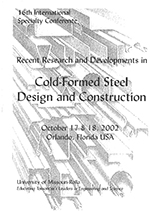Session Dates
17 Oct 2002
Abstract
Current American design provisions treat unstiffened elements under stress gradients as if they were uniformly compressed for effective width calculations. This paper presents a design method for calculating the effective width of these elements, based on plate test results. Current international codes allow the capacity of sections that contain unstiffened elements under stress gradients to be calculated on the basis of initiation of yielding in the section. A non-iterative method for the calculation of the capacity, based on inelastic reserve capacity, is presented. The method is shown to be in good agreement with experimental data of I-sections and plain channels in minor axis bending. Particular attention is given to the effect of both the elastic buckling coefficient used in the effective width method, and the use of inelastic considerations, on the bending capacity of sections that contain unstiffened elements under stress gradients.
Department(s)
Civil, Architectural and Environmental Engineering
Research Center/Lab(s)
Wei-Wen Yu Center for Cold-Formed Steel Structures
Meeting Name
16th International Specialty Conference on Cold-Formed Steel Structures
Publisher
University of Missouri--Rolla
Document Version
Final Version
Rights
© 2002 University of Missouri--Rolla, All rights reserved.
Document Type
Article - Conference proceedings
File Type
text
Language
English
Recommended Citation
Bambach, M. R. and Rasmussen, Kim J. R., "Design Provisions for Sections Containing Unstiffened Elements under Stress Gradients" (2002). CCFSS Proceedings of International Specialty Conference on Cold-Formed Steel Structures (1971 - 2018). 1.
https://scholarsmine.mst.edu/isccss/16iccfss/16iccfss-session1/1
Design Provisions for Sections Containing Unstiffened Elements under Stress Gradients
Current American design provisions treat unstiffened elements under stress gradients as if they were uniformly compressed for effective width calculations. This paper presents a design method for calculating the effective width of these elements, based on plate test results. Current international codes allow the capacity of sections that contain unstiffened elements under stress gradients to be calculated on the basis of initiation of yielding in the section. A non-iterative method for the calculation of the capacity, based on inelastic reserve capacity, is presented. The method is shown to be in good agreement with experimental data of I-sections and plain channels in minor axis bending. Particular attention is given to the effect of both the elastic buckling coefficient used in the effective width method, and the use of inelastic considerations, on the bending capacity of sections that contain unstiffened elements under stress gradients.



